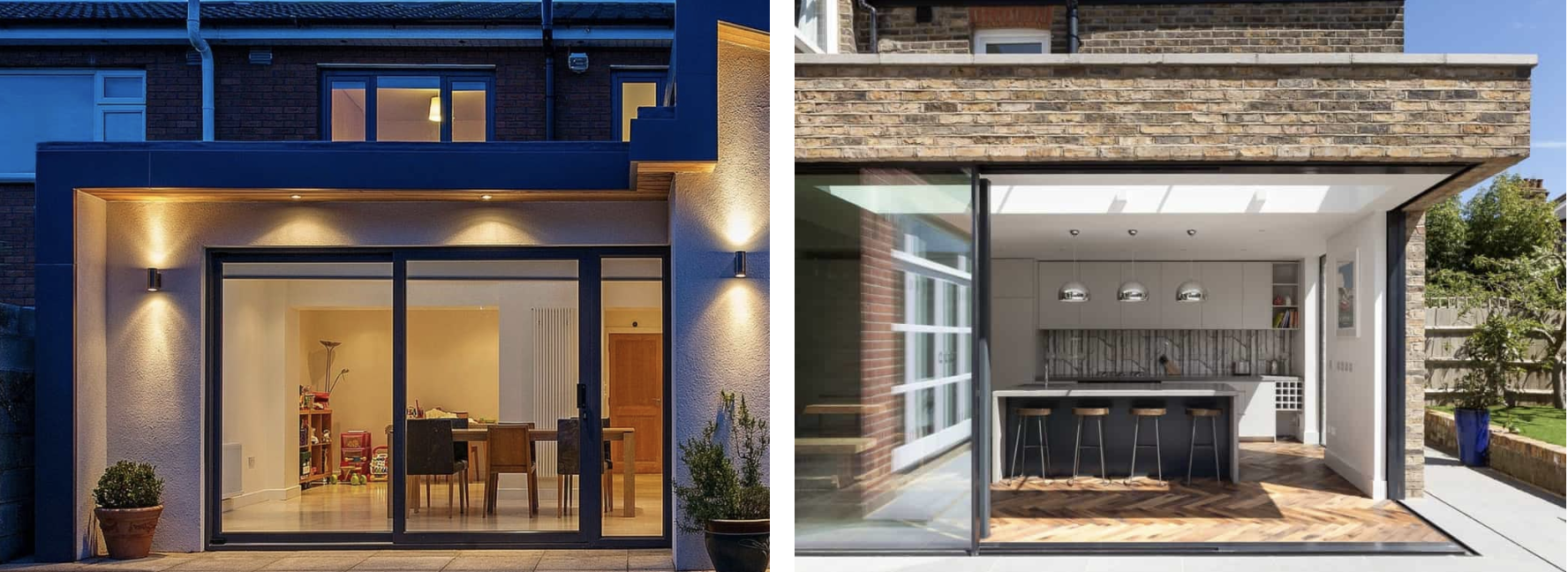Extensions designed by a design and build company (above left) and an independent architect (above right), both registered on Design for Me. Click the images to see their full profiles and shortlist them for your project.
Should I use the builder’s architect or an independent one?
When looking to do an extension or home renovation project, many homeowners consider using a one-stop-shop builder who can do the design work as well as the construction for a fixed fee. In the industry, this is called ‘design and build‘ and differs from the ‘traditional’ route where you appoint your architect/designer to do the design and drawing work first AND THEN get quotes and appoint your builder. The ‘design and build’ route provides early cost certainty as well as a single point of contact. This is very attractive and it may well be the best option for you. However, it shouldn’t be a decision taken too lightly and the aim of this article is to give you all the information you need to make the best decision for your particular project.
The extension is so simple, do I even need an architect at all?
Last week we asked, ‘Do I need an architect for a home extension?’. In summary, we advised that although you might not need an ‘architect’, it is important to use a design professional to help design and draw your project before building it! In that article we looked at the different kind of architectural design professionals – from qualified ‘architects’ to ‘technologists’ to ‘architectural designers’ – which you can read about here: Different architectural designer types)
Pros and cons of ‘design and build’ vs the ‘traditional’ route
1. The traditional route
(Using an independent architect or designer)
What’s the process?
- You select an independent architect / design professional.
- They analyse your needs then come back to you with a concept design.
- Once agreed, they submit planning drawings (if required).
- Then they prepare drawings and a specification for construction.
- This set of documents is bundled up and given to your chosen builders for their quotations and timescales.
- If a builder’s quote is acceptable, you will sign a contract and building work can start. See our article: Do I need a contract with my builder?
Advantages of the traditional route – Design quality & flexibility
1. Choice of architect / designer
Rather than being landed with your builder’s designer, you are free to select carefully the right design professional to suit your particular needs, style and budget. A great design professional will be able to deliver the best design for your project, at a budget you feel comfortable with. They’ll advise where to spend and where to save, to ensure you end up with a home you really love.
2. Your architect / designer works for you, and not your builder.
Your builder’s in-house designer will be looking for ways to keep costs down for the builder, which may not result in the best possible design for your brief. An independent architect has no other interest in anything other than achieving the best design for you, within your budget.
3. Changing your mind isn’t as expensive as it is with design and build
By the time your builder gets involved, you will have gone through a detailed design process and at this point you should be happy with your proposals to ensure you get an accurate price from your builder. However, it’s relatively straightforward to ask for changes after this point, as your builder will let you know the cost implications as you go.
Design and Build
(where the builder / loft company has an in-house or connected design professional)
- You approach design and build companies at the beginning of your project.
- After initial meetings(s), they provide a lump sum quotation for the entire project, which includes their designer’s fees, and you sign a contract with them.
- You start the design process with their designer.
- Once agreed, they submit planning drawings (if required).
- The design process continues, often overlapping with the construction.
Advantages of design and build – Easy, speedy and cost certainty
1. It’s quick
This is the main advantage of using a one-stop-shop to design and build your extension. Loft companies, for example, can complete project after project very quickly. Don’t expect any design awards for creativity, but they know what works and how to build in the most cost and time-efficient way.
2. A single point of contact
Many homeowners like the simplicity of dealing with only one company. There is less chance of mis-communication and misunderstanding along the way. This alone, speeds things up and results in fewer headaches for you.
3. You agree a fixed maximum price early on
Cost certainty is another big draw to the design and build route. But do note that I haven’t said it’s less expensive necessarily; more on that below.
Is it cheaper to use a design and build company?
There isn’t a clear-cut answer to this, unfortunately. It’s a misconception to think you’re saving on architect’s fees. Instead, your builder will simply roll this into their quote.
The advantage of your builder and designer working together is that, between them, they can find the most cost-effective way of constructing your extension and some of this saving (hopefully) will be passed to you through their quote. In doing this, they might opt for the cheaper building materials which aren’t necessarily the best. So, yes it might be cheaper but there is certainly an element of ‘you get what you pay for’.
However, as costs are fixed so early on in the design process with design and build, changing your mind about aspects of your project can be much more costly than with the traditional route.
Before you appoint anyone to carry out design work – a checklist
Whether you opt for an independent architect or design professional or decide to work with a design and build company, it’s always worth bearing these things in mind:
- Do they hold adequate insurance to protect you from errors in their work (Professional Indemnity Insurance)?
- If not, their drawings and specifications should not be used for construction. Instead, the design liability could to be passed onto your builder. For example, the architectural designer could prepare preliminary drawings for planning only. Then, the contractor can develop the design into detailed construction drawings and take responsibility under their own design insurance (note this insurance needs to specifically cover the design liability, which is different to a builder’s usual construction liability insurance).
- Have they done similar projects before? Ask to see examples when you meet.
- Get references from their previous clients.
Where do I start?
Design for Me is a free platform to help you quickly find the right design professional for your home project. As a residential architect myself, I started Design for Me after finding that talented and innovative smaller firms and individuals, who are perfectly placed to design new homes, extensions and/or renovations, can often get buried under the online profiles of large commercial companies.
Before Design for Me, the right person to design your home project was very difficult to find!
Once you register your project, we’ll match it with 100s of top architects and architectural designers all over the UK, and you can see who may be available and eager to work on your project straight away.
Emily Design for Me

